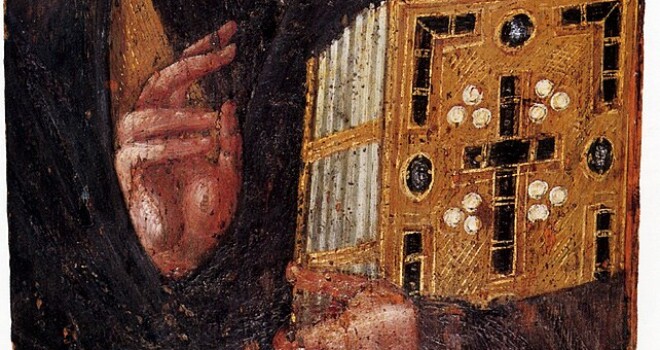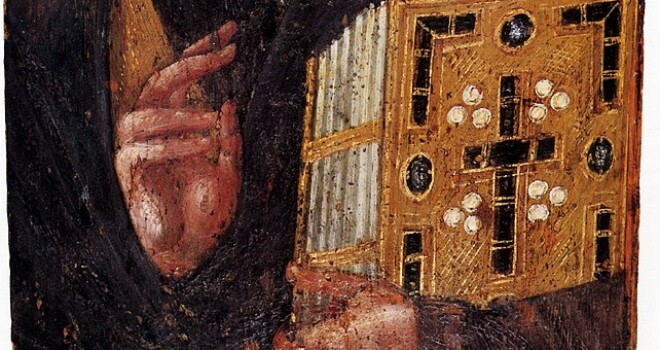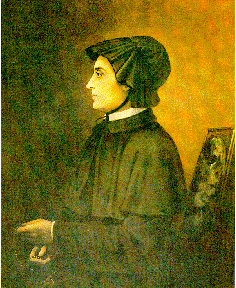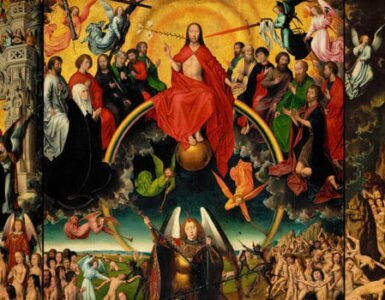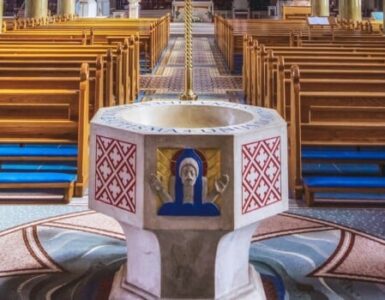Viewing and pondering sacred art, engaging in vizio divina, offers the faithful a great way to meditate more deeply on the life of Jesus Christ and the mystery of salvation. This series of articles will highlight several pieces of art related to the glorious Easter season, with specific attention to Scripture readings. Each of these pieces of art allows us to reflect on the astonishing realities of the resurrected life.
During the Fifth & Sixth Sundays of Easter, the Church proclaims Gospel passages from Jesus’ Last Supper Discourse. In Year A, the Gospel passages for these two Sundays come from the fourteenth chapter of John’s Gospel. Some of the best-known axioms stated by Jesus Christ, as well as some of His most significant promises, appear in this chapter. In this discourse, Jesus shares with His apostles and disciples the contours of their sharing in the life of grace that would be available to them after the Resurrection.
In the Christian tradition, there is a dearth of art relating specifically to this discourse. Perhaps that fact is because of the mysterious and mystical nature of Jesus’ words recorded by St. John. Therefore, we have an opportunity to look outside of the western artistic tradition and ponder icons as part of our ongoing series on vizio divina. Icons present a more mystical and mysterious style of art. The icon itself, the way it is produced, gives viewer a specific window into the divine mystery, and it has the power to lead that viewer into meditative and contemplative prayer.
One common iconic image of Jesus is Christ Pantocrator (translated as “Christ, Ruler of All,” or “Christ, Almighty”). There are many, many well-known versions of Christ Pantocrator around the world, especially in eastern churches (the Church of the Holy Sepulcher in Jerusalem, for example). The oldest and one of the best-known resides at the foot of Mount Sinai at the Eastern Orthodox Monastery of Saint Catherine. It has been fostering meditation on Jesus, the Almighty, since at least the A.D. 600s.

This icon depicts Jesus alone. This is eminently appropriate for the Last Supper Discourse. The five chapters that record this episode consist of nearly a complete monologue. There are only a few interlocutions from the apostles to which He was speaking. Jesus and His words are the focal point of the description by St. John, and He is the focal point by the iconographer of Saint Catherine’s Monastery.
The fact that Jesus is alone in the icon provides the viewer an opportunity to ponder the Lord’s statements about himself at greater length. “I will come back again and take you to myself,” He says. “I am the way and the truth and the life. No one comes to the Father except through me” (Jn. 14:3, 6). How often have I allowed myself to focus solely on Jesus? How often have I considered that He intends to speak these words directly to me, without worrying about details other than my relationship with Him?
One of the realities that comes through strongly in Jesus’ discourse, especially in John 14, is the union of Jesus Christ and the Heavenly Father, the First and Second Persons of the Trinity. Jesus answers Philip’s request to be shown the Father: “If you know me, the you will also know my Father. … Whoever has seen me has seen the Father. … Do you not believe that I am in the Father and the Father is in me? … Believe me that I am in the Father and the Father is in me…” (Jn. 14:7-11). Have I explored the truth that Jesus is, in fact, the Perfect Revelation of the Heavenly Father, with Whom He shares the fullness of the Divine Nature? Do I realize that when I relate to Jesus, I am brought closer to the Heavenly Father as well?
This particular icon offers an interesting detail for reflection on another important theological reality. Looking closely, a viewer will notice that the two halves of Jesus’ face are subtly distinct. This detail offers the opportunity to reflect on the hypostatic union, the fact that Jesus was, at the same time, both fully divine and fully human. The one face of Jesus is made up of two distinct halves. In a similar way, it is by examining the Person of Jesus Christ closely that we come to know Him in both His divinity and His humanity, and the distinct ways that He manifests each nature. Have I sought deeper understanding of the Person of Jesus Christ, in both His humanity and divinity?
In His left arm, Jesus cradles a book. Presumably the book is the Sacred Scriptures, perhaps specifically the Gospels. There are multiple ways that Jesus’ words in this discourse relate to the Sacred Scriptures. On the Sixth Sunday of Easter, we hear Jesus tell the faithful, “If you love me, you will keep my commandments. … Whoever has my commandments and observes them is the one who loves me” (Jn. 14:15, 21). It is important for us to realize that the story of God’s covenantal love, which is revealed in Sacred Scripture, comes along with commandments, rules and regulations for how to honor that relationship. We learn to keep the commandments in two parts: first, in learning what those commandments are (specifically, the Decalogue and the Beatitudes); second, by understanding the ways that faithful disciples have responded previously. In order to be in deeper relationship with Jesus, have I immersed myself in the story of Sacred Scripture? Because I love Him and want to keep the relationship, have I learned God’s commandments? Have I become convinced that my actions need to align with His commands and desires for my life?
Finally, the viewer notices that Jesus raises His right hand in blessing. This is a visible depiction of two promises that Jesus made during this discourse. First, He promises to send the Holy Spirit: “And I will ask the Father, and he will give you another Advocate to be with you always, the Spirit of truth, whom the world cannot accept…” (Jn. 14:16-17). Second, He tells the apostles and us, “I am the way, and the truth, and the life. …I live and you will live” (Jn. 14:6, 20). The blessing of Jesus Christ is something mysterious, something that even we cannot fully understand. Yet, His blessing sends for the Holy Spirit and bestows on us a first taste of the divine life in which we are meant to live and flourish. Do I seek out Jesus’ blessing, especially through the ordained ministers of the Church? Do I deprive myself of that gift, for example, by leaving Mass before the final blessing?
Christ Pantocrator is a window into the deep, eternal Mystery that is intended for all humanity to know and ponder. By pondering this icon, we are able to dive more deeply into that Mystery and grow in our relationship with the God-Man, Jesus Christ. In deepening our relationship with Our Blessed Lord, we are taught to turn our minds and hearts toward Him. By doing that, we know His Truth, we travel His Way, and we share in the Abundant Life that He lives.
Christ Pantocrator is in the public domain.


